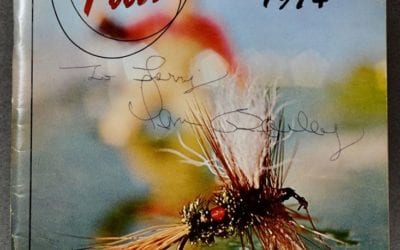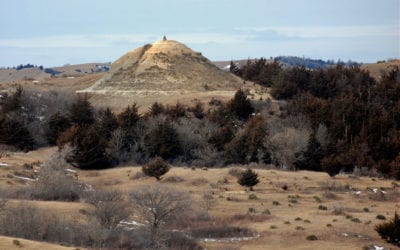My fishing partner and Team Outdoorsmen Productions member Larry Myhre, Sioux City, IA. Is one of those who uses a lot of old folk wisdom.
One of these is the old saying that goes something like this: “Nothing makes a fish bigger than almost being caught.”, Larry swears it’s true.
He says, it’s only the big ‘uns get away, as nothing adds pounds to a fish as quickly as losing one to a snag, a broken line or a thrown lure.
There’s a feeling of raw power extending down the rod, arched to the limit, and the line almost hums in the water in a brief fight that ends with a slack line. From long experience on the water, He says with some conviction that if the lost object was a bass, you can add two pounds, if a walleye three and if a catfish, northern pike or muskie, well, the sky may be the limit.
It’s not so much that fishermen tend to exaggerate on purpose, although it’s not a stretch to ponder if only liars’ fish or, on the other hand, whether or not all fishermen are liars? He indicates that, he’s about to tell you about some of the big fish that have gotten away from me.
I swear the following tales are true. And, in the eyes of the law I am what is called “a trained observer” so that should add even more credibility.
He calls the first tale, “The Moby Dick of the Missouri.”
This occurred many, many years ago near the beginning of his lifelong fishing odyssey. The place was the wild Missouri River somewhere near the town of Vermillion where he’d pursue, with varying degrees of seriousness, a degree in Journalism.
Somehow, he found the time to build a small wooden boat which he’d take on short excursions onto the big river.
He fished at night a lot for catfish and used a small kerosene lantern which provided almost enough light to tie a decent knot.
That night he rowed downstream through a small chute and a short way into the main river right where the current hit the bank and had created a deep hole. With the boat beached and the lantern glowing on the shoreline sand, He tied on the largest hook in his small tacklebox and crammed a whole lot of dead goldeye onto it before heaving it into the hole and beginning the wait.
An hour had probably passed when something picked up the bait and began moving off. His reel was in free spool, as he watched yard after yard of line peel off while waiting for the fish to make its run and stop. Finally, he just shut down the reel and heaved back as hard as he could.
He’d never hooked into a city bus, but he imagined it would feel a lot like that fish felt.
First the rod tip whipped down, then the whole rod and then both of my arms. All were on a level plane pointing at that fish.
Then it began to drag me. Then the line broke.
Even though the air was black with night, it turned blue with my shouted exhortations at that big fish. He was petty excitable in those days and have since learned to lose big fish with a lot more grace and decorum.
So that’s his first big fish lost story. The second happened a few years later underneath the Highway 71 bridge between West Lake Okoboji and East Lake Okoboji.
It was late fall and he’d spent the day fishing perch with some elderly friends who were well into their 50s. They tended to turn in about 10 o’clock which gave him the opportunity to do some night casting for walleyes under that bridge which most nights was pretty fruitful.
He’d just refilled the spool of my Mitchell 308 spinning reel with brand new four-pound-test line imported from France. Say what you want about the French, but in the late 1960s they made the best spinning line.
He pitched a hand-tied 1/16-ounce jig into the darkness under the bridge and set the hook when I felt the line twitch.
It was a solid hook set to say the least and the five-foot fiberglass rod bent almost in two and then straightened out to point down the line as fish headed for East Lake. All he could do was hang on and watch the new line peel off the spool against the brake.
If the fish would turn, he felt he might have a chance. Earlier that fall he’d landed a 20-pound carp in Lazy Lagoon on West Lake on the same outfit. But this fish didn’t turn. He completely spooled him, finally breaking the line at the knot.
He didn’t know what kind of fish it was. Maybe a big buffalo snagged in the fin. Or maybe Okoboji’s version of the Loch Ness monster?
He often said I don’t mind losing a fish if I can just see it first. Well, the next big lost fish story is one he did see. It was a northern pike and my guess is… Well, let’s just say big, like Real BIG.
Here’s what happened.
In the late 1970s I made a lot of my own fishing tackle. My winter project had been spinnerbaits and one I made was a monster. It was the King Kong of spinnerbaits, far bigger, much flashier and prettier than anything I had seen on the market. The arm of the bait extended back over the hook, fully eight inches above the point. Three spinners, bigger than a tablespoon rode on that wire festooned with big red and chartreuse beads. The head was dressed in white bucktail. It had two hooks in tandem, both dressed in bucktail making the bait about one foot long.
He took it on a family trip to northeastern Minnesota’s big Lake Vermillion. The lake has 1,250 miles of shoreline, 365 islands and many shallow, weedy bays. It was on one of these weedy bays, Greenwood Bay, that he raised the big fish.
He’d take the kids there evenings where they would cast Johnson Silver Minnows and catch hammer handle northern’s. The action was usually so fast I didn’t even bother to fish. I simply released northern after northern that the kids caught.
This night things were a little slower and he eyed the big spinnerbait and wondered what it would look like coming through the water.
Tying it directly to his line, not using a steel leader because I really didn’t expect a big northern to be in this bay at this time.
Besides, I doubted there would be a fish in the lake big enough to engulf this entire lure.
Well, during the first cast, Larry was admiring the big flashy lure pulsing through the clear water just under the surface when I noticed two big eyeballs behind it. Yep, that was the first thing I saw, two eyeballs. Then, as he cranked it closer he saw a snout the size of a spade.
Hs mind now plays back the whole scene in slow motion, a scene he recalled hundreds of times since.
The big snout opens, exposing a white maw with huge, sharp teeth and then it surges onto the bait. The mouth closes and the entire lure disappears.
The fish turns and the line relaxes, cut by those razor-sharp teeth.
There was no huge pull on the line, no boil or splash. Nothing to indicate the monster had even hit. His big flashy lure had simply been there one moment and was gone the next.
That’s how it is with big lost fish. They’re there one moment, gone the next. But the story remains for telling and retelling. Sometimes the fish just keep getting bigger and bigger. It’s kind of like the guy who caught a six-pound walleye in Canada and by the time he got home the fish weighed nine pounds. Now how did that happen?






0 Comments